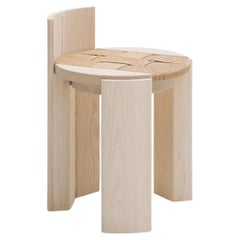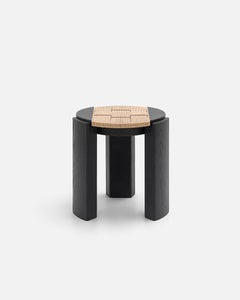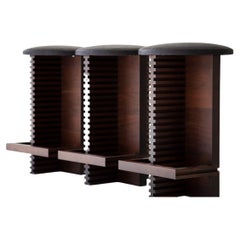SEM Stools
Furniture brand SEM started as a spin-off from Milanese brand Spotti and now has an exceptional reputation of its own. Working with acclaimed furniture designers, including Valentina Cameranesi Sgroi, Vormen and Elisa Ossino, SEM creates personalized and finely crafted solutions for modern living.
During the 1950s, large furniture manufacturers often had difficulty providing customized, high-quality furniture while producing other products on a mass scale. SEM originated from that demand and has evolved to complement Spotti and offer simple, functional and highly ergonomic furniture for both work and home environments.
SEM, which stands for Spotti Edizioni Milano, has attracted a wide range of talent to design its furniture collections. Pivot, named for a hingeless door mechanism in its cupboards, is a design by Giacomo Moor, named as Elle Decor Italia’s Best Young Designer of 2016. Futuraforma, designed by architecture and interior design team Marcante-Testa, is a sophisticated collection featuring the Duale table, the Genio chandelier and the Magico carpet.
Italian architect Hannes Peer lent his expertise to the Paesaggio collection, which features notable designs like the Nuvola armchair, the Alea dining chair, the Petali table lamp and the Butterfly table. Peer’s Butterfly console tables and other tables are a meeting between architecture, design and engineering to produce a complex and organic form that catches the eye.
SEM displayed collections at Milan Design Week in 2018 and 2019 and with AD France’s AD Intérieurs in 2019. SEM also expanded the Paesaggio collection during the 2021 FuoriSalone, Alcova, in Milan.
On 1stDibs, find a collection of SEM tables, seating, lighting and more.
21st Century and Contemporary Italian SEM Stools
Wood
21st Century and Contemporary Italian SEM Stools
Wood
2010s American Modern SEM Stools
Walnut
21st Century and Contemporary American SEM Stools
Aluminum
21st Century and Contemporary Polish Industrial SEM Stools
Stainless Steel
Mid-20th Century American Mid-Century Modern SEM Stools
Upholstery, Wood
21st Century and Contemporary Polish Industrial SEM Stools
Stainless Steel
21st Century and Contemporary Modern SEM Stools
Plastic
21st Century and Contemporary Polish Industrial SEM Stools
Stainless Steel
21st Century and Contemporary Polish Organic Modern SEM Stools
Stainless Steel
2010s Portuguese Modern SEM Stools
Bouclé, Oak
21st Century and Contemporary French Modern SEM Stools
Concrete
2010s French SEM Stools
Fabric, Wool
1920s Slovak Jugendstil Vintage SEM Stools
Beech, Bentwood







